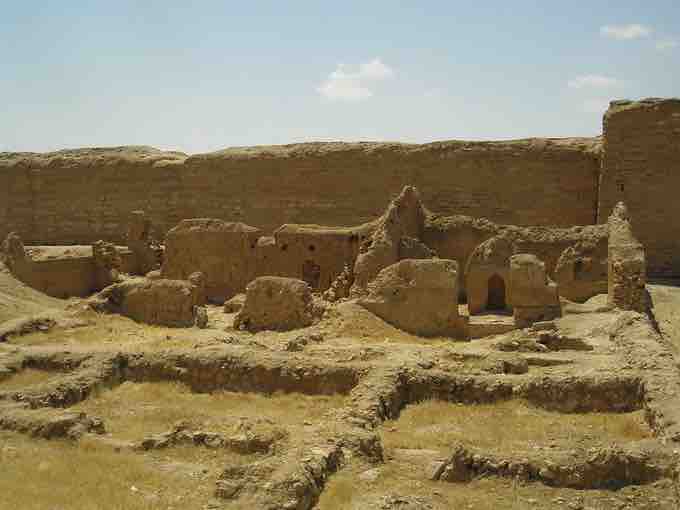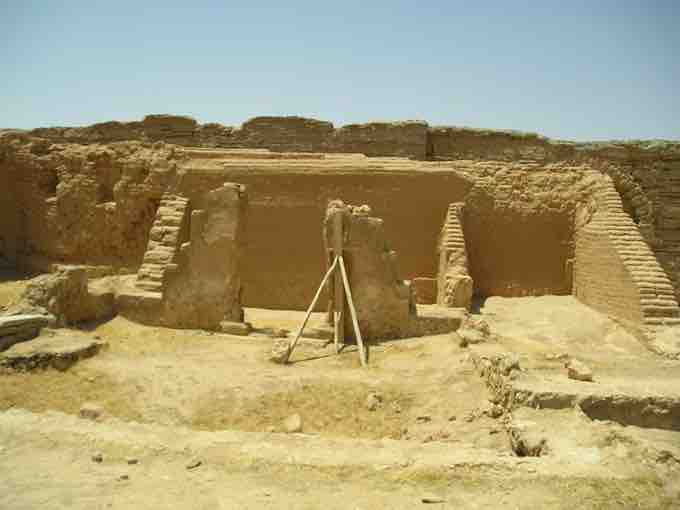Dura-Europos
Dura-Europos was a Hellenistic, Parthian and Roman border city built on an escarpment above the right bank of the Euphrates river. It is located near the village of Salhiyé, in today's Syria.
Its location on the edge of empires made for a co-mingling of cultural traditions, much of which was preserved under the city's ruins. Some remarkable finds have been brought to light, including numerous temples, wall decorations, inscriptions, military equipment, tombs, and even dramatic evidence of the Sassanian siege during the Imperial Roman period which led to the site's abandonment.
It was founded in 303 BC by the Seleucids on the intersection of an east-west trade route and the trade route along the Euphrates. During the late second century BC it came under Parthian control and in the first century BC, it served as a frontier fortress of the Arsacid Parthian Empire. There is proof of a multicultural population as inscriptions were discovered in Greek, Latin, Aramaic, Hebrew, Syriac, Hatrian, Palmyrenean, Middle Persian, and Safaitic Pahlavi. It was captured by the Romans in 165 CE and abandoned after a Sassanian siege in 256-257 CE. After it was abandoned, it was covered by sand and mud and disappeared from sight.
The Synagogue
An early Jewish synagogue is located by the western wall and dated by an Aramaic inscription to 244 CE. It is the best preserved of the many ancient synagogues of that era that have been uncovered by archaeologists. The synagogue, uncovered in 1932, contains a forecourt and house of assembly with frescoed walls depicting people and animals, and a Torah shrine in the western wall facing Jerusalem. The synagogue paintings, the earliest continuous surviving biblical narrative cycle, are conserved at Damascus, together with the complete Roman horse-armor. The synagogue was preserved, ironically, when it was filled with earth to strengthen the city's fortifications against a Sassanian assault in 256 CE .

Remains of Synagogue at Dura-Europos
This is the best preserved ancient synagogue to be uncovered by archaeologists.
The House Church
The Dura-Europos church also discovered at the site, is the earliest Christian house church, preserved by the same defensive fill that saved the synagogue.
When Christianity emerged in the late antique world, Christian ceremony and worship was much more private—even secretive—than it would become in the later Medieval periods. Before Christianity was legalized in the fourth century, Christians suffered intermittent periods of persecution at the hands of the Romans. Therefore, Christian worship was purposefully kept as inconspicuous as possible. Rather than building prominent new structures for express religious use, Christians in the late antique world took advantage of pre-existing, private structures—houses.
House churches were known as domus ecclesiae, Greek for house and assembly. Domus ecclesiae emerged in third century Rome and are closely tied to domestic Roman architecture of this period, specifically to the peristyle house in which the rooms were arranged around a central courtyard. These house churches had a central courtyard surrounded on three sides by a number of rooms. These rooms were often adjoined to create a larger gathering space that could accommodate small crowds of around fifty people. Other rooms were used for different religious and ceremonial purpose, including education, the celebration of the Eucharist, the baptism of Christian converts, storage of charitable items, and private prayer and mass .

Remains of House Church at Dura-Europos
House churches, where Christians congregated secretly, were common prior to the legalization of Christianity.
When Christianity was legalized in the fourth century, Christians were no longer forced to use pre-existing homes for their churches and meeting houses. Instead, they began to build churches of their own. Even then, Christian churches often purposefully featured unassuming—even plain—exteriors. They tended to be much larger as the rise in the popularity of the Christian faith meant that churches needed to accommodate an increasing volume of people.
The Mithraeum
The Mithraeum was also partially preserved by the defensive embankment . The earliest archaeological traces of the Roman Mithras cult found within the temple are from between 168 and 171 CE, which coincides with the arrival of Lucius Verus and his troops. At this stage it was still a room in a private home; it was extended and renovated circa 210 CE, and most of the frescoes are from this period. The mithraeum was enlarged again in 240 CE, but in 256 CE—with the war against the Sassanians looming—the sanctuary was filled in and became part of the strengthened fortifications. The surviving frescoes, graffiti and dipinti (which number in the dozens) are of enormous interest to the study of the social composition of the cult. The statuary and altars were found intact, as also the typical relief of Mithras slaying the bull.